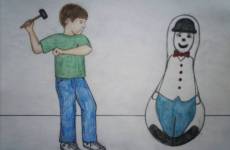Table of Contents
Social Cognitive Theory
General
Social cognitive theory, firstly known as social learning theory, was introduced in 1960s by a Canadian psychologist Albert Bandura and can in short be described in his own words:
- “Learning would be exceedingly laborious, not to mention hazardous, if people had to rely solely on the effects of their own actions to inform them what to do. Fortunately, most human behavior is learned observationally through modeling: from observing others one forms an idea of how new behaviors are performed, and on later occasions this coded information serves as a guide for action.”1)
What is social cognitive theory?
Basic principles of social cognitive theory were set in eralier works of Julian Rotter2), Neal Miller and John Dollard3). Bandura’s social learning theory starts from evolved assumption that we can learn by observing others. Key processes during this type of learning are observation, imitation, and modeling which as such involve attention, memory, and motivation4). People learn through observing others’ behavior, attitudes, and outcomes of those behaviors.
This theory therefore outgrows behaviorism and forms its connection to cognitivism as it claims people don't just respond to stimuli, but interpret them as well and includes cognitive aspects like motivation and attention.5) People are shaped by the outside world and at the same time they shape the outside world (“reciprocal determinism”) instead of just being machines modeled and conditioned by the environment.6) Bandura's theory is therefore often considered a bridge between behaviorist and cognitivist learning perspectives.
Most famous Bandura's experiment is the Bobo doll experiment, conducted in two forms in 19617) and 19638). In the experiment, a video of an adult behaving violently to a Bobo doll (inflatable, egg-shape balloon doll with a weight in the bottom part) was shown to three groups of children. The end of the video was, however, different for each group. The first video ended with the adult being rewarded for the violent behavior, in the second video he was punished for it, and in the third no consequences of his behavior were shown. After that, the children were let to play with the doll. The results showed how children imitated observed behavior, both boys and girls (although boys in greater percentage). The behavior was mostly imitated by the children from the group where violent behavior was rewarded in the video. As Bandura assumed, behavior was most likely to be adopted if it's result is observed as valuable.9)
The process of observational learning or modeling includes several steps10)11)12):
- Attention - paying attention to demonstrated behavior is necessary to be able to learn it.
- Retention - in order to learn a behavior it must be remembered (retained).
- Reproduction - converting symbolic representations from memory into appropriate actions.
- Motivation - in order to imitate a behavior a motivational factor must be present. Motivation can be positive (increasing probability of certain behavior) or negative (decreasing probability of certain behavior). Negative motivators don't cause learning. Motivators can be13):
- Past reinforcement/punishment - as in behaviorism.
- Promised reinforcements/punishment - motivators we can imagine or threats.
- Vicarious reinforcement/punishment - seeing and recalling the model being reinforced/punished.
Bandura suggests people don't just respond to external stimuli with a learned behavior, but can also control that behavior through self-regulation. Self-regulation involves three steps14):
- Self-observation - one looks at himself and his behavior keeping track of his actions.
- Judgment - one compares these observations with standards and expectations introduced by the society or himself.
- Self-response - if expectations are met, one gives himself a rewarding self-response and opposite. The self-responses one gives himself can vary from treating himself with a good meal to feelings of pride or shame.
Long range results of more positive self-responses are a higher self-concept (self-esteem). Negative self-responses according to Bandura result in lower self-concept and possibly compensation (superiority complex), inactivity (apathy or depression) or escape (drugs, television fantasies, even suicide). Bandura's suggestions for avoiding this states are that one should:
- learn an accurate picture of his behavior (considering self-observation),
- create meaningful and realistic standards (considering judgment), and
- use self-rewards instead of self-punishments (considering self-response).
What is the practical meaning of social cognitive theory?
Bandura's idea based on his theory was that a person with a psychological disorder could learn to deal with it by modeling a healthy person managing the same problem. He successfully experimented with modeling therapy on people with neurotic fear of snakes.
Social cognitive learning theory has also been applied very successfully to the understanding of aggression and other behavior modifications15), especially through media effects. Bandura warned that violent TV contents could be leading into a violent reality that is worth fearing.
Criticisms
Bandura's theory was criticized by biological theorists, who argued it ignores biological states and autonomic nervous system responses. It is a fact that some behaviors and responses are not only learned but partly inherited.
The Bobo doll experiment was also criticized for being too artificial16) and that if an adult was acting violently to a child, other children would not repeat the behavior; or that children were manipulated into repeating the aggressive behavior; or that children were only playing rather then aggressing the doll.
Bandura's ideas on violent behavior acquisition through media were also subjected to criticisms. Some authors have found that watching television actually reduces the amount of aggressive behavior since children can relate themselves with characters involved in an violent act and release their violent thoughts17) (the Catharsis effect).
Keywords and most important names
- Social learning, observational learning, reciprocal determinism, observing, modeling, self-concept, self-esteem, attention, retention, reproduction, motivation
Bibliography
Bandura, Albert. Social learning theory. Prentice Hall, 1977.
TIP: Theories. Social Learning Theory (A. Bandura). Retrieved February 17, 2011.
Isom, M. D. Albert Bandura. November 30, 1998. Retrieved February 18, 2011.
Boerre, G. Social learning theory of Albert Bandura. Retrieved July 9, 2011.
